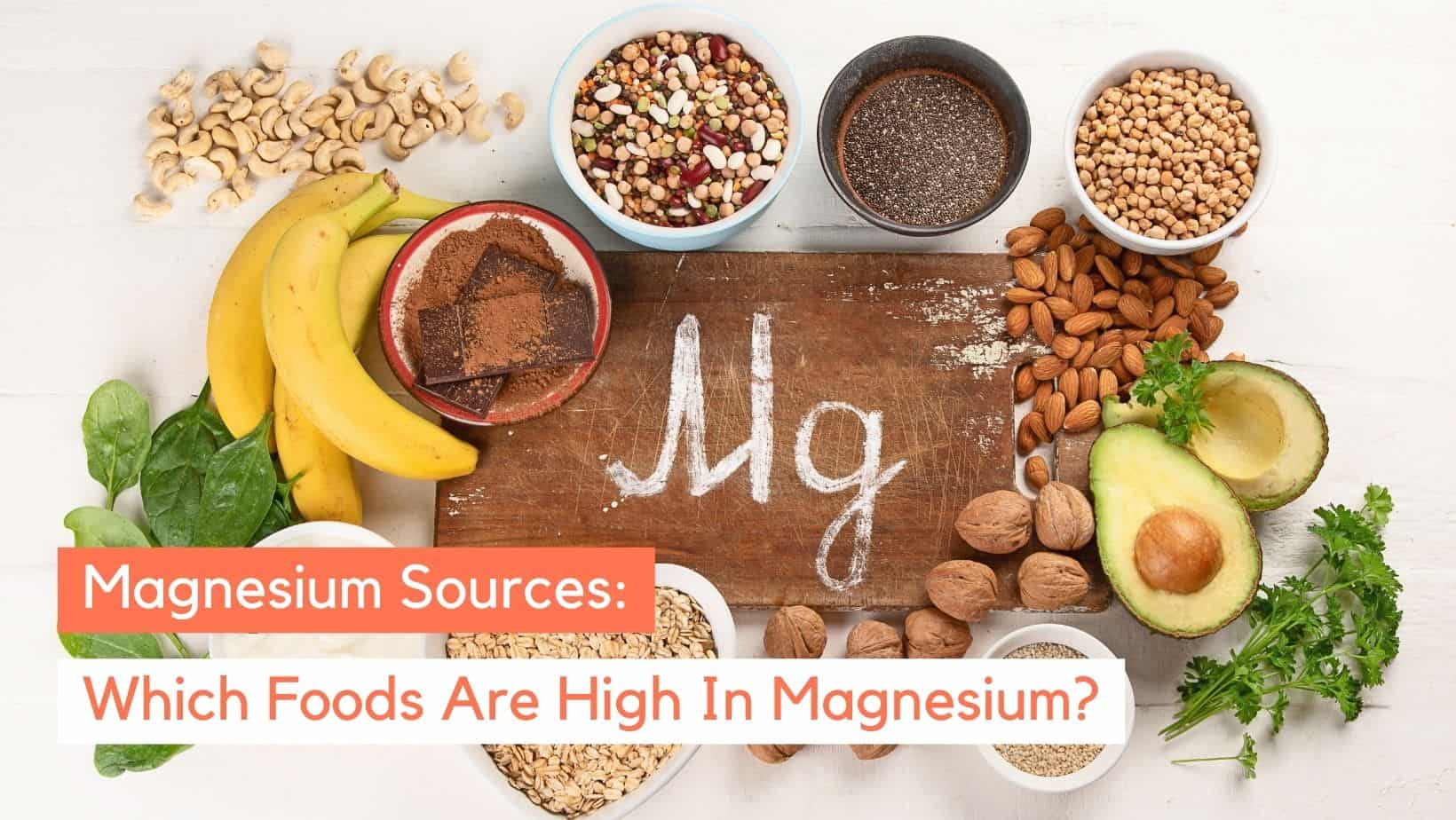Discover What Food Is Highest in Magnesium + Recipes
Magnesium is an essential mineral that plays a crucial role in our overall health and well-being. So, asking what food is highest in magnesium has become pretty common.
It is involved in numerous biochemical reactions in the body and is necessary for proper brain, muscle, and heart function.
Given its importance, it is essential to ensure that our diet includes sufficient magnesium. But which foods are highest in magnesium?
Let’s find out!
Understanding the Importance of Magnesium
Magnesium is often referred to as the “mighty mineral” due to its involvement in over 600 enzymatic reactions within our bodies.
This mineral is crucial for maintaining normal nerve and muscle function, supporting a healthy immune system, regulating blood pressure, and promoting bone health. Without adequate magnesium intake, we may experience a variety of health issues.
Let’s delve deeper into the fascinating world of magnesium and explore its numerous roles in the human body.
Role of Magnesium in the Human Body
Magnesium is not just a passive participant in our bodily functions; it plays an active and essential role in various physiological processes.
One of its key functions is energy production. Magnesium is a cofactor for many enzymes involved in the production of ATP, the main source of energy for our cells. Without sufficient magnesium, our energy levels may plummet, leading to fatigue and sluggishness.
Furthermore, magnesium is intricately involved in DNA synthesis and protein synthesis. It aids in the replication and repair of our genetic material, ensuring the proper functioning of our cells.
Magnesium also plays a crucial role in cardiovascular health. It helps maintain a steady heartbeat by facilitating the movement of electrical impulses through the heart.
This mineral also promotes relaxation by reducing stress and anxiety. It achieves this by regulating the release of stress hormones and neurotransmitters, promoting a sense of calm and tranquility.
Daily Recommended Intake of Magnesium
Now that we understand the multifaceted role of magnesium, let’s explore the recommended daily intake to ensure optimal health.
The Recommended Daily Allowance (RDA) for magnesium varies depending on age and gender.
Adult men should aim for around 400-420 milligrams (mg) per day, while adult women need slightly less at around 310-320 mg. Pregnant and lactating women have higher requirements, with an RDA of 350-360 mg and 310-320 mg, respectively.
It’s important to note that these values may differ for individuals with certain medical conditions or those on specific medications.
Consulting with a healthcare professional can provide personalized guidance on magnesium intake based on individual needs.
By ensuring an adequate intake of magnesium through a balanced diet or supplementation, we can support the optimal functioning of our bodies and reap the numerous health benefits associated with this mighty mineral.
Top Foods Rich in Magnesium
While magnesium is found in a wide range of foods, certain sources are particularly high in this vital mineral. Including these foods in your diet can help you meet your daily magnesium needs.
Magnesium is an essential mineral that plays a crucial role in various bodily functions. It is involved in more than 300 biochemical reactions in the body, including energy production, muscle function, and DNA synthesis.
Maintaining adequate magnesium levels is important for overall health and well-being.
Leafy Green Vegetables
Leafy greens, such as spinach, kale, and Swiss chard, are excellent sources of magnesium. These vegetables not only provide a good amount of magnesium but also offer other essential vitamins and minerals, making them a healthy addition to any meal.
Spinach, in particular, is a nutritional powerhouse. It not only contains magnesium but also provides iron, vitamin K, vitamin C, and folate. Incorporating spinach into your diet can help boost your magnesium intake while promoting overall health.
Kale is another leafy green vegetable that is rich in magnesium. It is also packed with antioxidants, fiber, and vitamins A, C, and K. Adding kale to your salads, smoothies, or stir-fries can be an excellent way to increase your magnesium levels and enhance your nutrient intake.
Swiss chard is yet another leafy green that deserves a spot on your plate. It is not only a great source of magnesium but also provides vitamins A, C, and K, as well as iron and potassium. Including Swiss chard in your meals can help you meet your magnesium needs while diversifying your nutrient intake.
Nuts and Seeds
Nuts and seeds, including almonds, cashews, pumpkin seeds, and chia seeds, are fantastic sources of magnesium. They are also rich in healthy fats, protein, and fiber, making them a nourishing snack option.
Almonds are not only delicious but also packed with nutrients. They are a great source of magnesium, vitamin E, and healthy fats. Snacking on almonds can provide you with a magnesium boost while offering numerous health benefits, such as reducing the risk of heart disease and improving brain function.
Cashews are another nut that is rich in magnesium. They also provide copper, zinc, and vitamin K. Incorporating cashews into your diet can help you meet your magnesium needs while adding a delightful crunch to your meals or snacks.
Pumpkin seeds are not only a tasty snack but also a great source of magnesium. They are also rich in iron, zinc, and omega-3 fatty acids. Sprinkling pumpkin seeds on salads, yogurt, or oatmeal can be an excellent way to increase your magnesium intake and add a pleasant texture to your meals.
Chia seeds are tiny powerhouses of nutrition. They are not only high in magnesium but also provide fiber, protein, and omega-3 fatty acids. Adding chia seeds to your smoothies, puddings, or baked goods can help you boost your magnesium levels while enhancing the nutritional value of your meals.
Whole Grains
Whole grains like quinoa, brown rice, and oats are not only high in fiber but also contain a decent amount of magnesium. Swapping refined grains for whole grains can significantly increase your magnesium intake while providing other essential nutrients.
Quinoa is a versatile grain that is not only rich in magnesium but also provides protein, fiber, and various vitamins and minerals. Incorporating quinoa into your meals can help you meet your magnesium needs while adding a nutty flavor and a pleasant texture to your dishes.
Brown rice is another whole grain that is packed with magnesium. It also provides fiber, B vitamins, and manganese. Replacing white rice with brown rice can be a simple yet effective way to increase your magnesium intake and improve the nutritional value of your meals.
Oats are a popular breakfast option that is not only filling but also rich in magnesium. They are also a great source of fiber, protein, and antioxidants. Starting your day with a bowl of oatmeal can provide you with a magnesium boost while keeping you satisfied and energized throughout the morning.
Incorporating these magnesium-rich foods into your diet can help you maintain optimal magnesium levels and support your overall health. Remember to combine them with a balanced diet consisting of a variety of fruits, vegetables, lean proteins, and healthy fats to ensure you meet all your nutritional needs.
Magnesium Content in Different Foods
While it’s helpful to know which foods are generally high in magnesium, it’s also crucial to understand the specific magnesium content of different foods.
Let’s take a closer look at some popular food choices and compare their magnesium levels.
Comparing Magnesium Levels in Various Foods
1. Spinach: One cup of cooked spinach contains approximately 157 mg of magnesium.
Spinach, a leafy green vegetable, is not only rich in iron but also a great source of magnesium. This essential mineral plays a vital role in maintaining normal muscle and nerve function, regulating blood sugar levels, and supporting a healthy immune system.
2. Almonds: A 1-ounce (28-gram) serving of almonds provides around 80 mg of magnesium.
Almonds, a popular tree nut, not only offer a satisfying crunch but also pack a punch when it comes to magnesium content. In addition to magnesium, almonds are also a good source of healthy fats, fiber, and vitamin E.
3. Quinoa: One cup of cooked quinoa contains about 118 mg of magnesium.
Quinoa, a versatile grain-like seed, is not only a great source of plant-based protein but also provides a significant amount of magnesium. This nutrient-rich ancient grain is also gluten-free, making it an excellent choice for individuals with dietary restrictions.
4. Black beans: A 1-cup serving of cooked black beans provides approximately 120 mg of magnesium.
Black beans, a staple in many cuisines, are not only rich in fiber and protein but also contain a decent amount of magnesium. These legumes are a great addition to vegetarian and vegan diets as they provide essential nutrients and contribute to overall health and well-being.
It’s worth noting that these values may vary slightly depending on factors such as soil quality and the specific variety of the food.
Incorporating Magnesium-Rich Foods into Your Diet
Now that you know which foods are rich in magnesium, you can easily incorporate them into your daily diet.
Magnesium is an essential mineral that plays a crucial role in various bodily functions, including muscle and nerve function, blood sugar regulation, and blood pressure control.
By including magnesium-rich foods in your meals, you can ensure that your body gets an adequate supply of this important nutrient.
Creating a Balanced Meal Plan
Start by planning your meals around whole, nutrient-dense foods that are naturally high in magnesium.
Leafy greens such as spinach and kale are excellent sources of magnesium. These greens not only provide you with magnesium but also offer a wide range of other vitamins and minerals.
Nuts and seeds, such as almonds, cashews, and pumpkin seeds, are also great options to include in your meals. These crunchy delights not only add a delightful texture to your dishes but also provide you with a good amount of magnesium.
Whole grains like quinoa, brown rice, and oats are another group of foods that are rich in magnesium. These grains are not only versatile but also packed with fiber, which aids in digestion and helps you feel fuller for longer. By incorporating these grains into your meals, you can create a balanced and nutritious diet.
For example, you could enjoy a spinach salad with diced almonds for lunch and a quinoa stir-fry with mixed vegetables for dinner.
These meals not only provide you with a good amount of magnesium but also offer a variety of flavors and textures to keep your taste buds satisfied.
Incorporate at least three servings of magnesium-rich foods throughout the day to ensure you meet your daily requirements. By spreading out your intake, you give your body a steady supply of this essential mineral.
Eating a variety of foods will not only provide the necessary magnesium intake but also add more flavors and textures to your meals.
Quick and Easy Magnesium-Rich Recipes
If you’re looking for quick and easy recipes to boost your magnesium intake, try these ideas:
Spinach and Feta Omelet:
- Whisk together 3 eggs, a handful of spinach, and crumbled feta cheese. Sauté in a non-stick pan until cooked through. Serve with whole-grain toast.
- Not only does this omelet provide you with a good amount of magnesium from the spinach, but it also offers a protein-packed breakfast to start your day off right. The feta cheese adds a tangy and creamy flavor that complements the spinach perfectly.
Almond and Berry Smoothie:
- In a blender, combine a handful of almonds, a cup of mixed berries, a banana, and your preferred liquid (such as almond milk or water). Blend until smooth and enjoy as a nutritious breakfast or snack.
- This smoothie is not only delicious but also a great way to increase your magnesium intake. Almonds are a fantastic source of magnesium, and when combined with the natural sweetness of berries and the creaminess of a banana, they create a delightful and nutritious drink.
By incorporating these recipes into your meal plan, you can easily boost your magnesium intake while enjoying tasty and satisfying meals.
Potential Risks of Magnesium Deficiency
While it’s important to strive for adequate magnesium intake, magnesium deficiency can occur in some individuals. This deficiency can lead to various health issues and should be addressed promptly.
Symptoms of Low Magnesium Levels
Common symptoms of magnesium deficiency include muscle cramps, fatigue, irritability, and abnormal heart rhythms. In severe cases, magnesium deficiency can lead to cardiovascular problems, migraines, and osteoporosis.
Long-Term Health Effects of Magnesium Deficiency
Untreated magnesium deficiency can have long-term health effects, impacting bone density, blood pressure regulation, and overall cardiovascular health. It’s essential to monitor your magnesium levels and seek medical advice if you suspect a deficiency.
Conclusion
Now that you know which foods are highest in magnesium, you can make informed choices when it comes to your diet.
By including magnesium-rich foods in your meals and following a balanced diet, you can ensure that you meet your daily magnesium requirements and support your overall health and well-being.
Remember, a varied diet that includes leafy greens, nuts, seeds, and whole grains can help you maintain optimal magnesium levels and promote a healthy lifestyle.
If your diet isn’t that good and you want to make sure you have enough magnesium every day, we highly recommend this full-spectrum magnesium supplement for daily use.
Magnesium deficiency is linked to stress, diabetes, heart disease, osteoporosis, chronic fatigue syndrome, depression, anxiety, trouble sleeping, sore muscles, migraines, and many more debilitating health conditions.
If your body needs magnesium, you want the most beneficial kind your body can actually absorb. Organixx Magnesium 7 gives you seven (7) of the very best, most bioavailable types of elemental magnesium available.






Comments